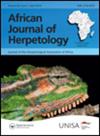非洲蜥蜴属Heliobolus的颅骨比较骨学和初步系统修正(角鲨目:蜥蜴科)
IF 0.9
4区 生物学
Q3 ZOOLOGY
引用次数: 4
摘要
摘要非洲撕裂蜥蜴(撕裂蜥蜴科:Eremiadini)的解剖结构鲜为人知,这阻碍了人们更好地了解它们的进化关系。这尤其适用于东非分支,包括Nucras属、Latastia属、Philochortus属、Pseuderemias属和Heliobolus属。我们使用X射线微计算机断层扫描对Heliobolus属的头骨骨学进行了详细描述,并将其形态与上述撕裂分类群进行了比较。由于Heliobolus属包括有效性和亲缘关系可疑的物种(Heliobolusneumanni和Heliobolussnitidus),我们还进行了详细的属内比较,并构建了一个形态特征矩阵,我们根据先前分子研究得出的系统发育主干进行分析。lugubris和spekii Heliobolus可以很好地描述为一个单系群,其特征是眶后较短,顶骨后缘持续较宽,与H.nitidus和东非分支的其他成员不同,其骨化程度总体较低,额骨的腹侧延伸减少。我们的初步系统发育分析表明,Heliobolus属目前是多系的。我们建议正式收回H.neumanni这个名字,因为在我们的分析中,分配给这个物种的标本显示出彼此非常不同的形态,并且被放置在树的不同部分。此外,模式标本丢失,没有从模式地区采集到任何标本。H.nitidus显示了一个朝向Latastia属的信号。根据分子数据,必须等待进一步的研究,才能确定新的H.nitidus属。本文章由计算机程序翻译,如有差异,请以英文原文为准。
Comparative skull osteology and preliminary systematic revision of the African lizard genus Heliobolus (Squamata: Lacertidae)
ABSTRACT The anatomy of African lacertid lizards (Lacertidae: Eremiadini) is poorly known, which has hindered a better understanding of their evolutionary relationships. This applies especially to the East African clade, which includes the genera Nucras, Latastia, Philochortus, Pseuderemias and Heliobolus. We present a detailed description of the skull osteology of the genus Heliobolus using X-ray microcomputed tomography and compare its morphology to the above lacertid taxa. Because the genus Heliobolus includes species of doubtful validity and affinities (Heliobolus neumanni and Heliobolus nitidus), we also present a detailed intrageneric comparison and construct a morphological character matrix that we analyse against a phylogenetic backbone derived from previous molecular studies. Heliobolus lugubris and Heliobolus spekii can be well characterised as a monophyletic group on the basis of a short postorbital and a continuously broad posterior margin of the parietal, differing from H. nitidus and other members of the East African clade in an overall low degree of ossification and reduced ventral extension of the frontal bone. Our preliminary phylogenetic analysis suggests that the genus Heliobolus is currently polyphyletic. We propose that the name H. neumanni be officially retracted, because specimens assigned to this species show very different morphologies relative to each other and are placed in different parts of the tree in our analysis. Also, the type specimen is lost and no specimens were collected from the type locality. H. nitidus shows a signal towards the genus Latastia. A definitive, new generic assignment of H. nitidus must await further investigations based on molecular data.
求助全文
通过发布文献求助,成功后即可免费获取论文全文。
去求助
来源期刊

African Journal of Herpetology
ZOOLOGY-
CiteScore
3.00
自引率
6.70%
发文量
15
审稿时长
>12 weeks
期刊介绍:
African Journal of Herpetology (AJH) serves as an outlet for original research on the biology of African amphibians and reptiles. AJH is an interdisciplinary journal that publishes original articles and reviews from diverse fields and disciplines, such as conservation, phylogenetics, evolution, systematics, performance, physiology, ecology, behavioural ecology, ethology, and morphology.
The Journal publishes two issues a year. There are no page charges .
 求助内容:
求助内容: 应助结果提醒方式:
应助结果提醒方式:


